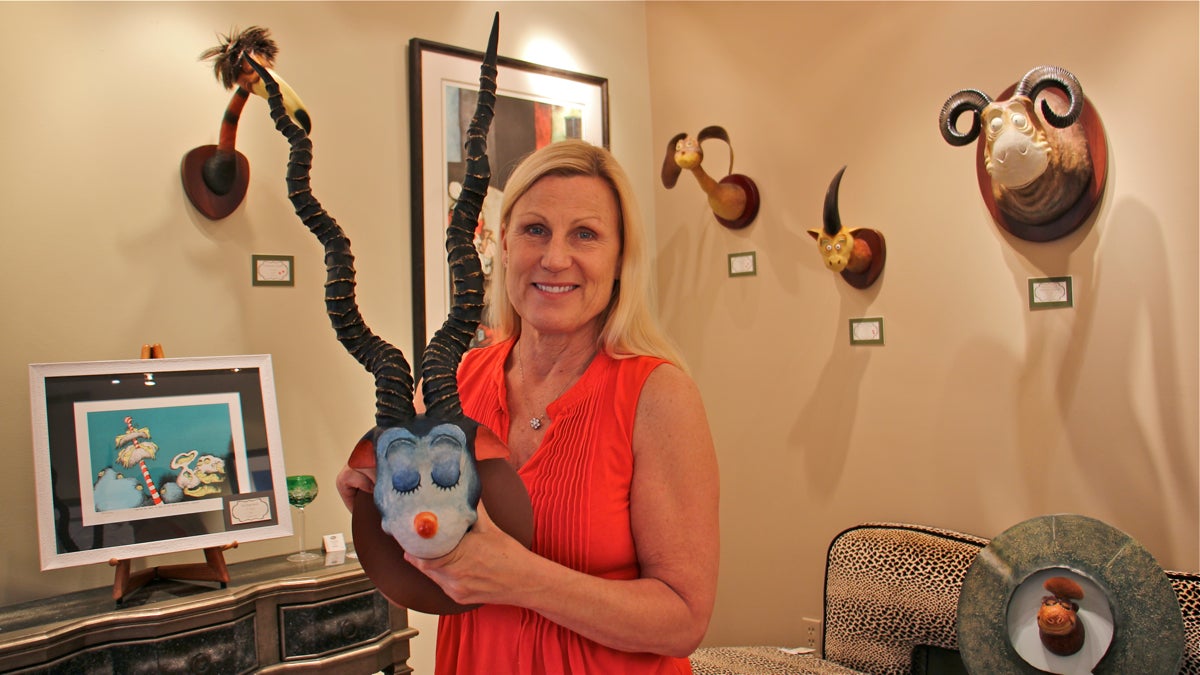Before Thing 1: Early Dr. Seuss inspirations on display at Jersey shore gallery

Before Theodor Geisel became Dr. Seuss, he began work on an array of faux taxidermy sculptures that foreshadowed the characters in his children's books. Resin reproductions can be seen and purchased at Ocean Galleries in Avalon. (Emma Lee/WHYY)
Dr. Seuss, the legendary children’s book author, not only drew whimsical creatures for his stories, he sometimes sculpted them as three-dimensional objects.
He made 17 sculptures in the early part of his career, all on display at the Jersey Shore, at Oceans Galleries in Avalon.
They were made before Dr. Seuss was Dr. Seuss.
In the early 1930s, Theodore Geisel was living in New York scratching out a living as a young illustrator and cartoonist. He got a gig creating advertising for Esso marine oil. He invented a series of cartoon fish that represented all the terrible things that could happen to your engine if you used bad oil, like the powerless puffer, and the carbonic walrus.
“His job was to sell oil for boats,” said Jeffrey Schuffman, curator with the Art of Dr. Seuss Collection. “He created a campaign of two-dimensional traditional advertising that appeared in Yachting magazine and in other places. Some of those characters he invented for that campaign he made into three-dimensional characters that were on display at the National Motorboat Show in NYC.”
Geisel’s father worked at a zoo in Massachusetts, and would mail his son animals parts. Antlers, beaks, fur were all used as models for drawing. Geisel kept them in a box under his bed, becoming inspired to use them in sculptures. The whimsical creatures of what he called “Unorthodoxed Taxidermy” were mounted heads of imaginary animals constructed out of plaster and those animal parts.
Even at that early stage in Geisel’s career, the signature look of what would become Dr. Seuss was there: the heavy eyelids, the goofy smiles, and spindly long necks with poofy hairballs.
When Geisel adopted the name Dr. Seuss and published his first book – “And To Think That I Saw It On Mulberry Street” (1937) – he created more sculptures of characters, out of antlers, bird beaks, and plaster, to be used as advertising in bookstores.
Geisel created 17 sculptures in total; all of them are now in private collections.
The Art of Dr. Seuss Collection has been fabricating limited-edition recreations of those sculptures, one a year for two decades. Now, all seventeen sculptures – cast in resin and hand-painted (no real animals beaks or antlers involved) – are part of a traveling exhibition of Seuss work, including limited edition prints of his working sketches, production drawings with printer’s notes, and editorial cartoons.
The exhibit has been bouncing around the country for about a year, currently at Oceans Gallery, a licensed Seuss dealer.
“Some of the collectors are serious, they want to see the 17 sculptures,” said owner Kim Miller. “These sculptures are not available unless you buy them from the exhibit.”
In the back of Miller’s gallery are three reproductions of Seuss’s sculptures no longer available. Their run has sold out, never to be replenished.
WHYY is your source for fact-based, in-depth journalism and information. As a nonprofit organization, we rely on financial support from readers like you. Please give today.





